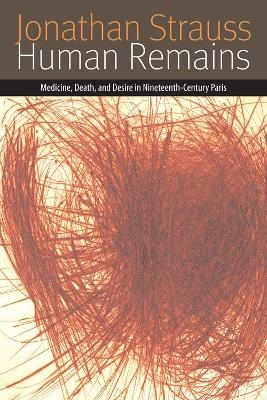
Human Remains
Medicine, Death, and Desire in Nineteenth-Century Paris
Seiten
2012
Fordham University Press (Verlag)
978-0-8232-3379-3 (ISBN)
Fordham University Press (Verlag)
978-0-8232-3379-3 (ISBN)
The living and the dead cohabited Paris until the late eighteenth century, when, in the name of public health, measures were taken to drive the latter from the city. Cemeteries were removed from urban space, and corpses started to be viewed as terrifyingly noxious substances.
The dead had fallen victim to a sustained reflection on the notions of life and death that emerged from the two new medical fields of biology and hygiene. In large part, the Paris of the nineteenth century—the Paris of modernity—arose, both theoretically and physically, out of this concern over the relations between the animate and the inanimate.
As the dead became a source of pervasive and intense anxiousness, they also became an object of fascination that at once exceeded and guided the medical imagination attempting to control them. Human Remains examines that exuberant anxiety to discover the irrational, indeed erotic, forces motivating the medicalization of death.
Working across a broad range of disciplines, including history, literature, the visual arts, philosophy, and psychoanalysis, the book seeks to understand the meaning of the dead and their role in creating one of the most important cities of the contemporary world.
The dead had fallen victim to a sustained reflection on the notions of life and death that emerged from the two new medical fields of biology and hygiene. In large part, the Paris of the nineteenth century—the Paris of modernity—arose, both theoretically and physically, out of this concern over the relations between the animate and the inanimate.
As the dead became a source of pervasive and intense anxiousness, they also became an object of fascination that at once exceeded and guided the medical imagination attempting to control them. Human Remains examines that exuberant anxiety to discover the irrational, indeed erotic, forces motivating the medicalization of death.
Working across a broad range of disciplines, including history, literature, the visual arts, philosophy, and psychoanalysis, the book seeks to understand the meaning of the dead and their role in creating one of the most important cities of the contemporary world.
Jonathan Strauss is Professor of French at Miami University. He is the author of Subjects of Terror: Nerval, Hegel, and the Modern Self and of Human Remains: Medicine, Death, and Desire in Nineteenth-Century Paris (Fordham).
| Reihe/Serie | Forms of Living |
|---|---|
| Verlagsort | New York |
| Sprache | englisch |
| Maße | 152 x 229 mm |
| Themenwelt | Geisteswissenschaften ► Geschichte ► Regional- / Ländergeschichte |
| Geisteswissenschaften ► Psychologie ► Trennung / Trauer | |
| Geisteswissenschaften ► Sprach- / Literaturwissenschaft ► Anglistik / Amerikanistik | |
| Studium ► Querschnittsbereiche ► Geschichte / Ethik der Medizin | |
| Sozialwissenschaften ► Soziologie ► Mikrosoziologie | |
| ISBN-10 | 0-8232-3379-0 / 0823233790 |
| ISBN-13 | 978-0-8232-3379-3 / 9780823233793 |
| Zustand | Neuware |
| Haben Sie eine Frage zum Produkt? |
Mehr entdecken
aus dem Bereich
aus dem Bereich
Die Geschichte eines Weltzentrums der Medizin von 1710 bis zur …
Buch | Softcover (2021)
Lehmanns Media (Verlag)
CHF 27,90
Krankheitslehren, Irrwege, Behandlungsformen
Buch | Softcover (2024)
C.H.Beck (Verlag)
CHF 55,90


